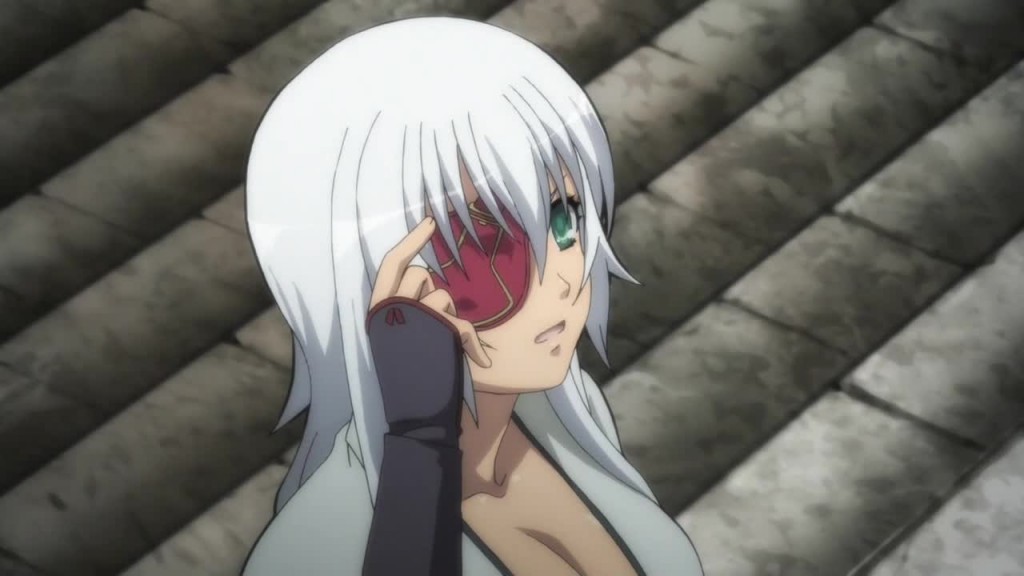Hyakka Ryouran Samurai Bride – the Yagyuu Dojo This entry was posted by Vale.
From left to right.
Hattori Hanzou (服部半蔵) was a famous master of the spear and ninja of the Sengoku era. The character in Kill Bill is named after him as well. Born in 1542 (Tenbun 11), he was a loyal man of the Tokugawa. Even centuries after his death in 1597 (Keichou 1) the Hanzomon (半蔵門 Gate of Hanzou, after the gate of his villa) metro line in Tokyo still bears his name. He’s attributed with many supernatural abilities, such as teleportation, clairvoyance and telekinesis.
Yagyuu Juubei (柳生十兵衛), also known by the name Mitsuyoshi (三厳). He was born in 1607 (Keichou 12) as the son of the Tokugawas’ swordsman Yagyuu Munenori. He occasionally filled in for his father as the trainer of Tokugawa shogun Iemitsu. Then he left court possibly embark on a long journey to improve his skills. He is well known for his Book of the Moon (月之抄), that summarized all that was to be known regarding the Shinkage style. Because close to nothing is known about him during his 12 years of travelling and this gives (script)writers great freedom with his portrayal, he appears very often as a mysterious samurai in fiction. He died in 1650 (Keian 3) under unknown circumstances.
Princess Sen (千姫) was born in 1597 (Keichou 2) as the daughter of shogun Tokugawa Hidetada. At the age of seven she was married to Toyotomi Hideyori and lived with him in the castle of Osaka until 1615 when the castle fell to Tokugawa Ieyasu (her grandfather). While most of Hideyori’s household died, Princess Sen was saved, and she in turn saved Hideyori’s daughter (from a concubine) Princess Naa (who would then become a well known and respected chief nun of the Toukei temple in Kamakura). Just a year later she was married to Honda Tadatoki and moved to Himeji.
Naoe Kanetsugu (直江兼続) was the chief retainer of the Uesugi lords, who were on the Toyotomi side. He was widely regarded as a wise man and a skilled strategist. Even his enemies praised him for his great command during his retreat from the siege of Hasedou after the Tokugawa victory at Sekigahara. He’s also known for developing the new Uesugi lands at Yonezawa and regulating the Mogami river after receiving pardons from and swearing loyalty to the Tokugawa. He fought on the Tokugawa side in the siege of Osaka. He died in 1620 (Genna 5).
Gotou Matabei (後藤又兵衛) was a samurai in the service of the Kuroda and Toyotomi families. He was born in 1560 (Eiroku 3). He was a great warrior who proved his skills in many battles including Toyotomi Hideyoshi’s campaign on Korea (he’s especially known for his achievements in the second siege of Jinju). He died in the siege of Osaka in 1615 (Keichou 20).
Sanada Yukimura (真田幸村), originally Nobushige (信繁) was a significant warlord of the Toyotomi (betrayed the Tokugawa and switched sides before the Battle of Sekigahara) side in the Sengoku era. Born in 1567 (Eiroku 10), he was regarded as a master tactician and a mighty warrior. After several victories against superior numbers and even holding the castle of Ueda against Tokugawa Hidetada’s forces, outnumbered 1:20. He played a huge role in the defense of Osaka during both the winter and summer sieges. While in the winter siege his forces successfully repelled the shogun’s attacks, in the summer siege he died as the castle fell.
Sarutobi Sasuke (猿飛佐助) is a fictional ninja, one of Sanada’s Brave Ten (yes, Brave 10 was based on their story). His character might be based on the historic Iga ninja Kouzuki Sasuke (who was also nicknamed Monkey of Tsuge by some). This is supported by that on the order of Tokugawa Ieyasu, Hattori Hanzo purged Iga as a retribution for his espionage during the summer siege of Osaka.
Gisen is probably based off Retsudou Gisen (列堂義仙), a Rinzai Buddhist monk, child of Yagyuu Munenori and the first head priest of the Yagyuu family’s Boutoku temple (1635-1702). He’s said to have been a very restless and wild person, often clashing with other members of the family. This is probably the reason why the characters based on him are either antagonists or controversial at best.



